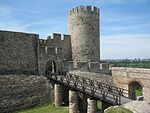Nebojša Tower
Buildings and structures completed in 1460Buildings and structures in BelgradeInstances of Lang-sr using second unnamed parameterRigas FeraiosTowers completed in the 15th century

Nebojša Tower (Serbian: Кула Небојша, romanized: Kula Nebojša; Greek: Πύργος Νεμπόισα) is the only surviving mediaeval tower of the Belgrade Fortress. Built in the 15th century, it was the major defensive tower of the fortress for centuries. Later it served as a dungeon and in 2010 it was adapted into the museum. The tower is located near the confluence of the Sava into the Danube.
Excerpt from the Wikipedia article Nebojša Tower (License: CC BY-SA 3.0, Authors, Images).Nebojša Tower
Bulevar vojvode Bojovica, Belgrade Old Town (Stari Grad Urban Municipality)
Geographical coordinates (GPS) Address Website External links Nearby Places Show on map
Geographical coordinates (GPS)
| Latitude | Longitude |
|---|---|
| N 44.827365 ° | E 20.447883 ° |
Address
Кула Небојша
Bulevar vojvode Bojovica
11000 Belgrade, Old Town (Stari Grad Urban Municipality)
Central Serbia, Serbia
Open on Google Maps










